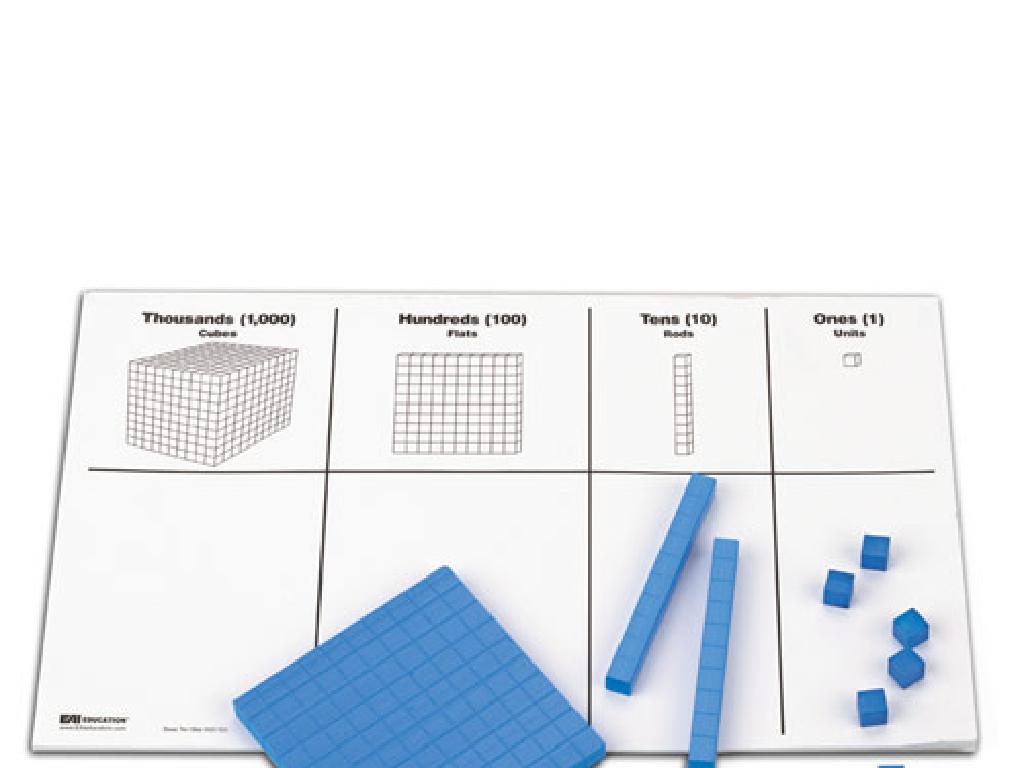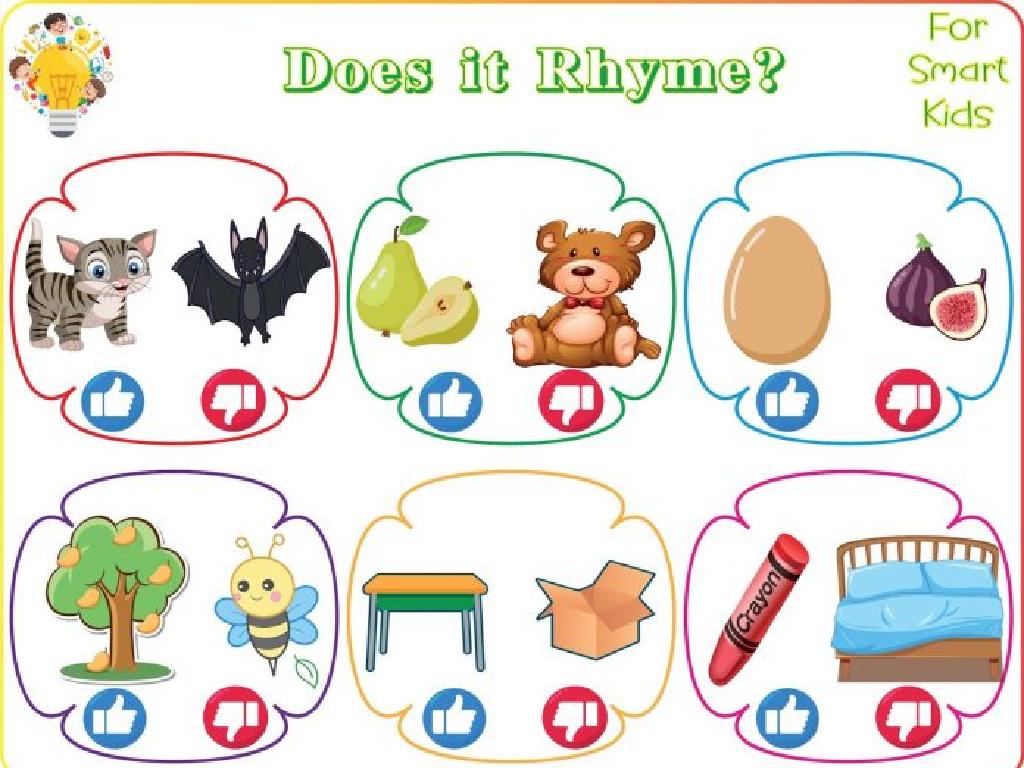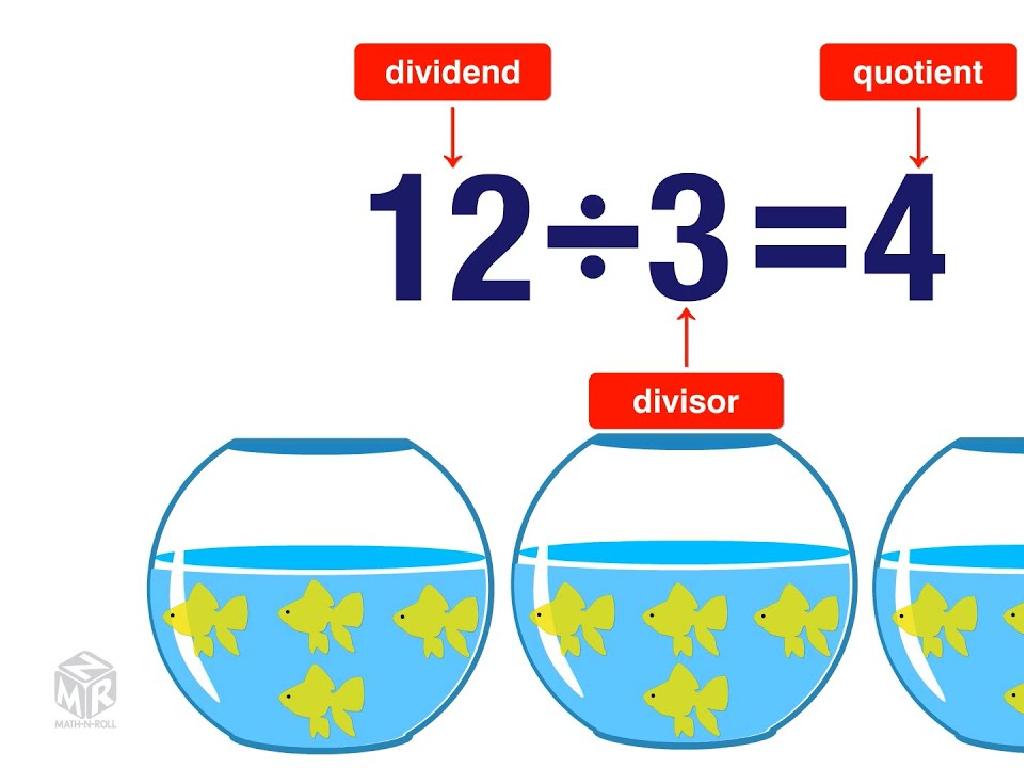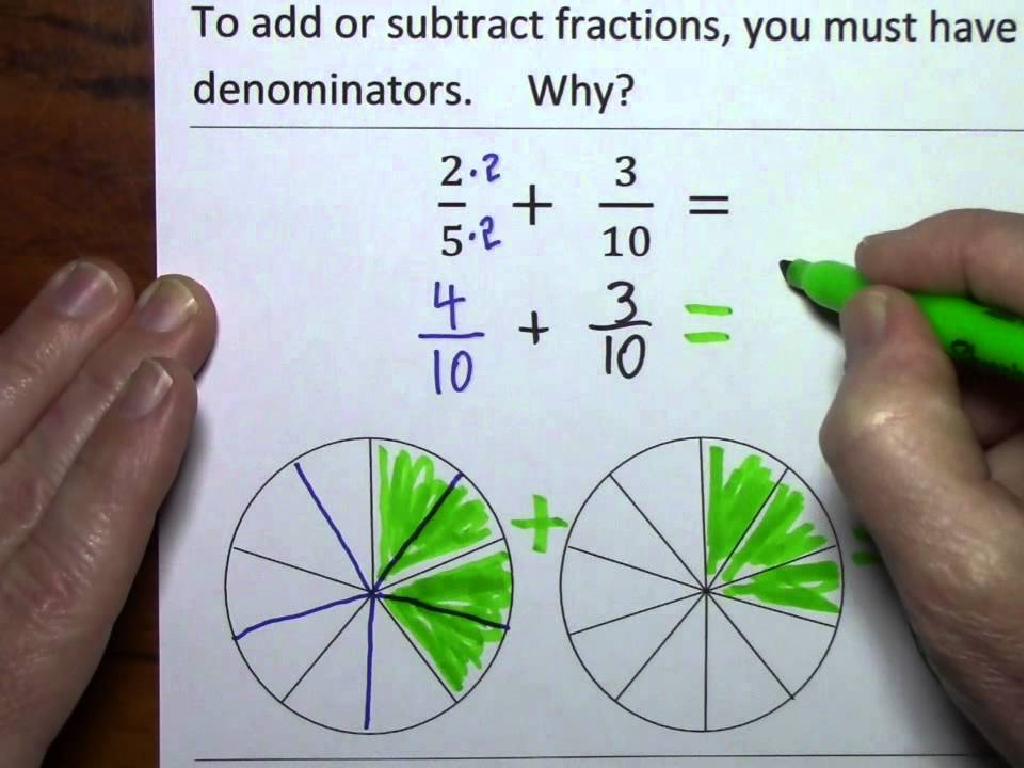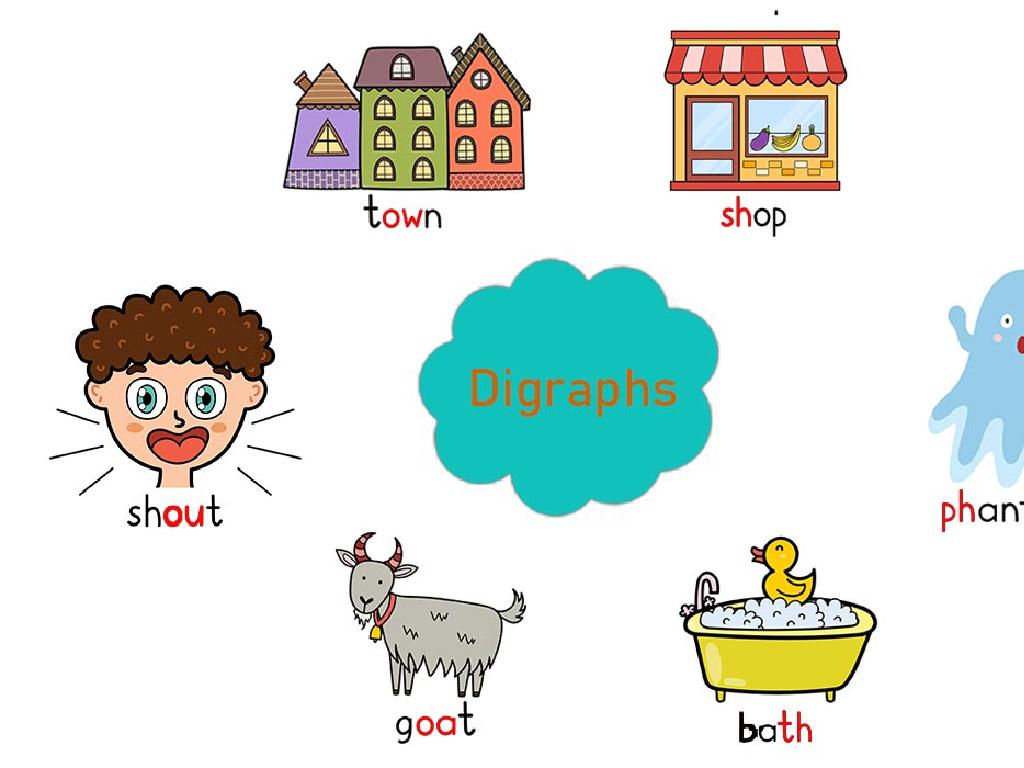Identify Text Structures
Subject: Language arts
Grade: Fourth grade
Topic: Text Structure
Please LOG IN to download the presentation. Access is available to registered users only.
View More Content
Welcome to Text Structures!
– How texts are organized
– Stories have a beginning, middle, and end
– Importance of text structures
– Knowing structure helps predict and understand
– Examples of text structures
– Like cause/effect, problem/solution, sequence
– Improving reading comprehension
– Recognizing patterns makes reading easier
|
This slide introduces students to the concept of text structures, which is the way stories and informational texts are organized. Understanding text structures is crucial for students as it aids in predicting what might happen next and comprehending the material more deeply. Examples of text structures include cause and effect, problem and solution, and chronological order. By recognizing these patterns, students can better understand the content and improve their reading comprehension skills. Encourage students to think about the structure of their favorite stories and discuss how it helped them understand the story better.
Exploring Text Structures
– What is text structure?
– How information in a passage is organized
– Types of text structures
– Description, Sequence, Cause/Effect, Compare/Contrast, Problem/Solution
– Recognizing structure clues
– Look for keywords, signal words that indicate the type of structure
– Importance of text structures
|
This slide introduces the concept of text structure to fourth-grade students, explaining that it’s the way information is organized in a passage. Highlight the different types of text structures such as Description, Sequence, Cause and Effect, Compare and Contrast, and Problem and Solution. Teach students to recognize these structures by looking for specific clues in the text, like keywords or signal words. Understanding text structures will help students comprehend and analyze reading materials more effectively. Encourage them to think of examples from books they’ve read or stories they’ve heard that fit into each structure type.
Understanding Description Structure
– What is Description Structure?
– It’s used to share details about a topic.
– Spotting Description in Texts
– Look for descriptive words and sensory details.
– Adjectives and Imagery
– Words that paint a picture in your mind.
– Example: Describing a Rainforest
– A lush rainforest with tall trees and bright flowers.
|
The Description Structure in texts helps students to visualize and understand a topic by providing detailed information. Teach students to identify this structure by looking for descriptive language, such as adjectives and imagery, which create a vivid picture in the reader’s mind. Use the example of a rainforest description to show how these elements work together to convey a sense of the environment. Encourage students to practice by describing something familiar to them, like their bedroom or a favorite place, using lots of adjectives and sensory details.
Understanding Sequence Structure
– Sequence shows order of events
– Like steps in a recipe or directions
– Signal words: ‘first’, ‘next’, ‘then’
– These words cue the order of events or steps
– Example: Model airplane instructions
– Step-by-step guide to assemble a plane
– Why it’s important: Helps organize information
|
This slide introduces the concept of sequence structure in texts, which is crucial for understanding the order in which events or steps occur. Emphasize the importance of signal words that indicate sequence, such as ‘first’, ‘next’, ‘then’, and ‘finally’. Use the example of instructions for building a model airplane to illustrate a practical application of sequence structure. Explain that recognizing this structure helps students follow along and comprehend the material better, whether it’s in writing, instructions, or storytelling. Encourage students to look for these signal words in their reading and to use them in their writing to clearly communicate the order of events.
Understanding Cause and Effect in Texts
– What is Cause and Effect?
– It shows why something happened (cause) and the results (effect).
– Signal words to identify
– Look for ‘because’, ‘therefore’, ‘as a result’ in texts.
– Example: Dinosaur extinction
– A story might explain the cause of dinosaurs’ extinction and its effects on Earth.
– Practice finding causes and effects
|
This slide introduces the concept of the cause and effect structure in texts, which is crucial for students to understand how events are interconnected. Start by explaining that a cause is why something happens, and an effect is what happens as a result. Highlight signal words that often indicate a cause and effect relationship. Use the example of dinosaur extinction to illustrate a real-world application of this text structure. Encourage students to think of their own examples and to practice identifying cause and effect in texts they read. This will help them to better comprehend and analyze the information presented in various types of literature and informational texts.
Understanding Compare and Contrast Structure
– What is Compare and Contrast?
– It shows how things are alike and different.
– Key words to look for
– Words like ‘similar’, ‘different’, and ‘alike’ signal comparisons.
– Example: Story characters
– Like comparing traits of two heroes in a book.
|
This slide introduces the compare and contrast text structure, which is used to analyze the similarities and differences between two or more items. Emphasize to students that this structure helps readers understand and organize information by considering how things are alike and how they are different. Encourage students to look for specific words that signal a comparison or contrast, such as ‘similar’, ‘different’, ‘in contrast’, and ‘alike’. Use an example from a familiar story where two characters are compared by their actions, appearance, or decisions. This will help students grasp the concept and apply it to their reading. In the next class, students can practice by comparing two characters from a book they are currently reading.
Understanding Problem and Solution Structure
– Recognize ‘problem and solution’
– Text presents an issue and ways to fix it
– Signal words to identify structure
– Words like ‘problem’, ‘solution’, ‘solve’ guide us
– Example: Pollution and its reduction
– A story might explain the issue of pollution and how to lessen it
– Practice finding problem and solution
|
This slide introduces the ‘problem and solution’ text structure, which is commonly found in various reading materials. Students should learn to identify this structure by looking for specific signal words that indicate a problem is being presented and solutions are being offered. An example to illustrate this structure is a passage discussing the issue of pollution and various ways to reduce its impact. Encourage students to think of other examples and to practice identifying this structure in their reading. This will help them better understand the author’s intent and improve their comprehension skills.
Exploring Text Structures
– Spotting text structures
– Look for patterns in the text to identify its structure.
– Practice with key words
– Words like ‘first’, ‘then’, ‘finally’ can signal sequence.
– Author’s purpose for structures
– Different structures can persuade, inform, or entertain.
– Class activity: Find the Clues
|
This slide introduces students to the concept of text structures and how to identify them in various readings. Emphasize that recognizing text structures helps in understanding the material better. Encourage students to look for specific words and phrases that signal different structures, such as cause and effect, sequence, or compare and contrast. Discuss why an author might choose a particular structure and how it serves the text’s purpose. For the class activity, provide short paragraphs with different structures and ask students to identify them using clues from the text. This will help reinforce their learning and improve their analytical skills.
Class Activity: Text Structure Scavenger Hunt
– Work in groups for a scavenger hunt
– Use various reading materials
– Magazines, newspapers, or excerpts
– Identify different text structures
– Look for description, sequence, comparison, cause and effect, or problem and solution
– Share and explain your findings
– Discuss as a class why each example fits a text structure
|
This activity is designed to help students recognize and understand the five main text structures in a fun and interactive way. Divide the class into small groups and provide a mix of magazines, newspapers, and excerpts. Each group’s task is to find real-life examples of the different text structures: description, sequence, comparison, cause and effect, and problem and solution. After the hunt, each group will present their findings to the class, explaining the context clues that led them to identify the text structure. This will foster critical thinking and collaborative learning. As a teacher, facilitate the discussion and guide students towards understanding how authors organize information in texts. Prepare to offer additional examples if students struggle to find certain structures.
Conclusion: Understanding Text Structures
– Recap the five text structures
– Chronological, Cause/Effect, Compare/Contrast, Problem/Solution, Description
– Why structures improve comprehension
– Recognizing patterns helps predict and understand information
– Apply knowledge in the next class
– We’ll practice identifying structures in new reading materials
|
As we wrap up today’s lesson, it’s important to review the five main text structures: chronological, cause and effect, compare and contrast, problem and solution, and description. Understanding these structures is crucial as they are the building blocks of comprehension, allowing students to better predict and understand the information presented in texts. In our next class, we will take this knowledge further by applying it to new texts, enhancing our reading and comprehension skills. Encourage students to review these structures at home and come prepared to discuss examples of each.

